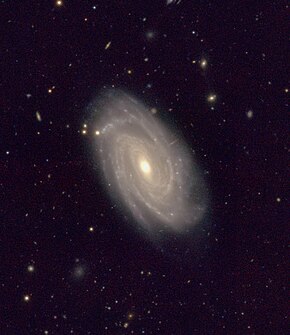| NGC 10 | |
|---|---|
 NGC 10
ESO KIDS | |
| Observation data (J2000 epoch) | |
| Constellation | Sculptor |
| Right ascension | 00h 08m 34.53660s [1] |
| Declination | −33° 51′ 30.1884″ [1] |
| Redshift | 0.022719±0.000033 [2] |
| Heliocentric radial velocity | 6,811±10 km/s [2] |
| Distance | 346.3 Mly (106.17 Mpc) [3] |
| Apparent magnitude (V) | 13.3 |
| Absolute magnitude (V) | −21.55 |
| Characteristics | |
| Type | SAB(rs)bc [4] or SBbc [5] |
| Apparent size (V) | 1.373′ × 0.879′ [6] |
| Other designations | |
| PGC 634, [5] ESO 349-32, MCG-06-01-024 [7] | |
NGC 10 is a spiral galaxy located in the southern constellation of Sculptor. It was discovered by John Herschel on 25 September 1834. [8] The galaxy is located at a distance of 346 Mly from the Sun. [3] Its morphological classification in the De Vaucouleurs system is SAB(rs)bc, [4] where the 'SAB' denotes a weak- barred spiral, '(rs)' indicates a slight ring-like structure, and 'bc' means the spiral arms are moderately to loosely wound. [9] Paturel et al. (2003) assigned this galaxy a classification of SBbc, indicating a barred spiral galaxy. [5]
On 22 December 2011, a Type II supernova designated SN 2011jo was discovered in NGC 10 by Stuart Parker of New Zealand. It was located 2″ east and 16″ north of the galactic nucleus. [10]
See also
References
- ^ a b Brown, A. G. A.; et al. (Gaia collaboration) (August 2018). "Gaia Data Release 2: Summary of the contents and survey properties". Astronomy & Astrophysics. 616. A1. arXiv: 1804.09365. Bibcode: 2018A&A...616A...1G. doi: 10.1051/0004-6361/201833051. Gaia DR2 record for this source at VizieR.
- ^ a b Mathewson, D. S.; et al. (August 1992). "A Southern Sky Survey of the Peculiar Velocities of 1355 Spiral Galaxies". Astrophysical Journal Supplement. 81: 413. Bibcode: 1992ApJS...81..413M. doi: 10.1086/191700.
- ^ a b Tully, R. Brent; et al. (2016). "Cosmicflows-3". The Astronomical Journal. 152 (2): 50. arXiv: 1605.01765. Bibcode: 2016AJ....152...50T. doi: 10.3847/0004-6256/152/2/50. S2CID 250737862.
- ^
a
b de Vaucouleurs, G.; et al. (1991). "Third reference catalogue of bright galaxies". 9. New York:
Springer-Verlag.
{{ cite journal}}: Cite journal requires|journal=( help) - ^ a b c Paturel, G.; et al. (December 2003), "HYPERLEDA. I. Identification and designation of galaxies", Astronomy and Astrophysics, 412: 45–55, Bibcode: 2003A&A...412...45P, doi: 10.1051/0004-6361:20031411.
- ^ Skrutskie, Michael F.; Cutri, Roc M.; Stiening, Rae; Weinberg, Martin D.; Schneider, Stephen E.; Carpenter, John M.; Beichman, Charles A.; Capps, Richard W.; Chester, Thomas; Elias, Jonathan H.; Huchra, John P.; Liebert, James W.; Lonsdale, Carol J.; Monet, David G.; Price, Stephan; Seitzer, Patrick; Jarrett, Thomas H.; Kirkpatrick, J. Davy; Gizis, John E.; Howard, Elizabeth V.; Evans, Tracey E.; Fowler, John W.; Fullmer, Linda; Hurt, Robert L.; Light, Robert M.; Kopan, Eugene L.; Marsh, Kenneth A.; McCallon, Howard L.; Tam, Robert; Van Dyk, Schuyler D.; Wheelock, Sherry L. (1 February 2006). "The Two Micron All Sky Survey (2MASS)". The Astronomical Journal. 131 (2): 1163–1183. Bibcode: 2006AJ....131.1163S. doi: 10.1086/498708. ISSN 0004-6256. S2CID 18913331.
- ^ "NGC 10". SIMBAD. Centre de données astronomiques de Strasbourg. Retrieved 16 January 2017.
- ^ "New General Catalog Objects: NGC 1 - 49". cseligman.com. Retrieved 2017-11-22.
- ^ de Vaucouleurs, Gérard (April 1963). "Revised Classification of 1500 Bright Galaxies". Astrophysical Journal Supplement. 8: 31. Bibcode: 1963ApJS....8...31D. doi: 10.1086/190084.
- ^ Bock, G.; Parker, S. (December 2011). "Supernova 2011jo in NGC 10 = PSN J00083457-3351148". Central Bureau Electronic Telegrams. 2964: 1. Bibcode: 2011CBET.2964....1B.
External links
- NGC 10 on WikiSky: DSS2, SDSS, GALEX, IRAS, Hydrogen α, X-Ray, Astrophoto, Sky Map, Articles and images
- "Distance Results for NGC 0010". NASA/IPAC Extragalactic Database. Retrieved 2010-05-03.
- SEDS